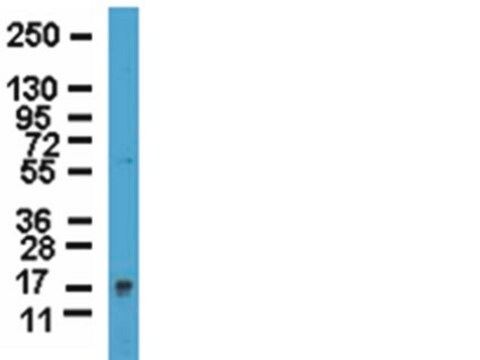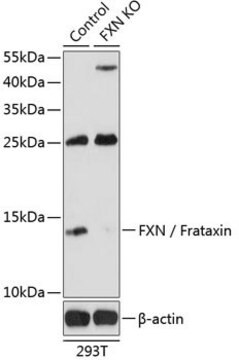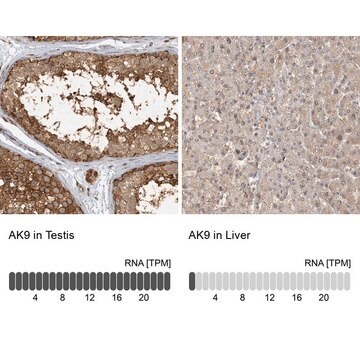MAB1594
Anti-Frataxin Antibody, exon 4, clone 1G2
ascites fluid, clone 1G2, Chemicon®
Synonyme(s) :
Friedreich ataxia, Friedreich ataxia protein
About This Item
Produits recommandés
Source biologique
mouse
Niveau de qualité
Forme d'anticorps
ascites fluid
Type de produit anticorps
primary antibodies
Clone
1G2, monoclonal
Espèces réactives
human, rat, mouse
Fabricant/nom de marque
Chemicon®
Technique(s)
ELISA: suitable
immunocytochemistry: suitable
immunofluorescence: suitable
western blot: suitable
Isotype
IgG1κ
Numéro d'accès NCBI
Numéro d'accès UniProt
Conditions d'expédition
dry ice
Modification post-traductionnelle de la cible
unmodified
Informations sur le gène
human ... FXN(2395)
mouse ... Fxn(14297)
rat ... Fxn(499335)
Description générale
Spécificité
Immunogène
Application
1:100-1:1,000. Fixation of cells in ice cold acetone or 4% paraformaldehyde is recommended. Due to the subcellular localization of frataxin in the mitochondria, cells should be permeabilized in the presence of detergent prior to incubation with primary antibody.
ELISA:
A previous lot of this antibody was used on ELISA.
Western blot (natural and recombinant protein):
1:5,000; mitochondrial preparations are recommended for consist signals (see Santos, 2001).
Optimal working dilutions must be determined by the end user.
Qualité
Western Blot Analysis:
1:1000 dilution of this lot detected Frataxin on 10 μg of PC12 lysates.
Description de la cible
Forme physique
Stockage et stabilité
Handling Recommendations: Upon first thaw, and prior to removing the cap, centrifuge the vial and gently mix the solution. Aliquot into microcentrifuge tubes and store at -20°C. Avoid repeated freeze/thaw cycles, which may damage IgG and affect product performance
Remarque sur l'analyse
Liver, heart or skeletal muscle.
Autres remarques
Informations légales
Vous ne trouvez pas le bon produit ?
Essayez notre Outil de sélection de produits.
Code de la classe de stockage
11 - Combustible Solids
Classe de danger pour l'eau (WGK)
WGK 1
Point d'éclair (°F)
Not applicable
Point d'éclair (°C)
Not applicable
Certificats d'analyse (COA)
Recherchez un Certificats d'analyse (COA) en saisissant le numéro de lot du produit. Les numéros de lot figurent sur l'étiquette du produit après les mots "Lot" ou "Batch".
Déjà en possession de ce produit ?
Retrouvez la documentation relative aux produits que vous avez récemment achetés dans la Bibliothèque de documents.
Notre équipe de scientifiques dispose d'une expérience dans tous les secteurs de la recherche, notamment en sciences de la vie, science des matériaux, synthèse chimique, chromatographie, analyse et dans de nombreux autres domaines..
Contacter notre Service technique








